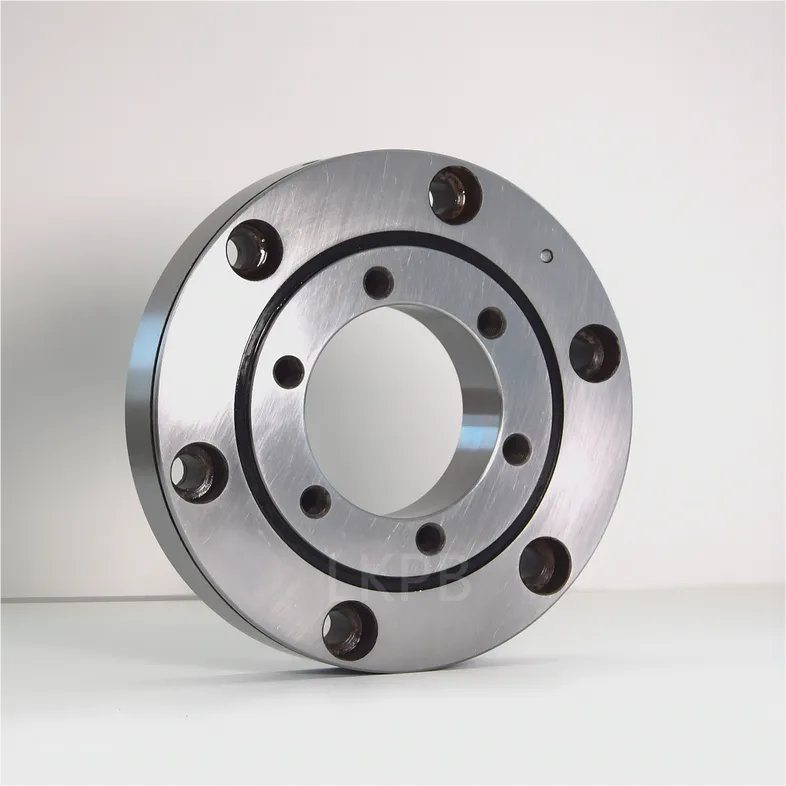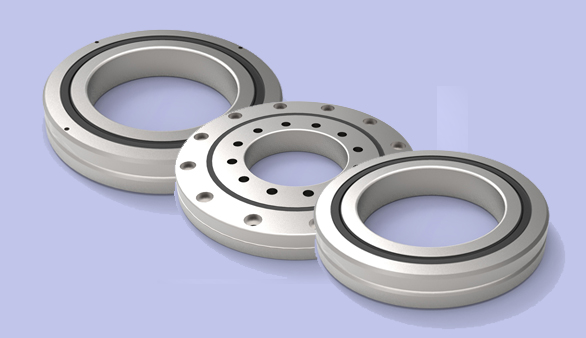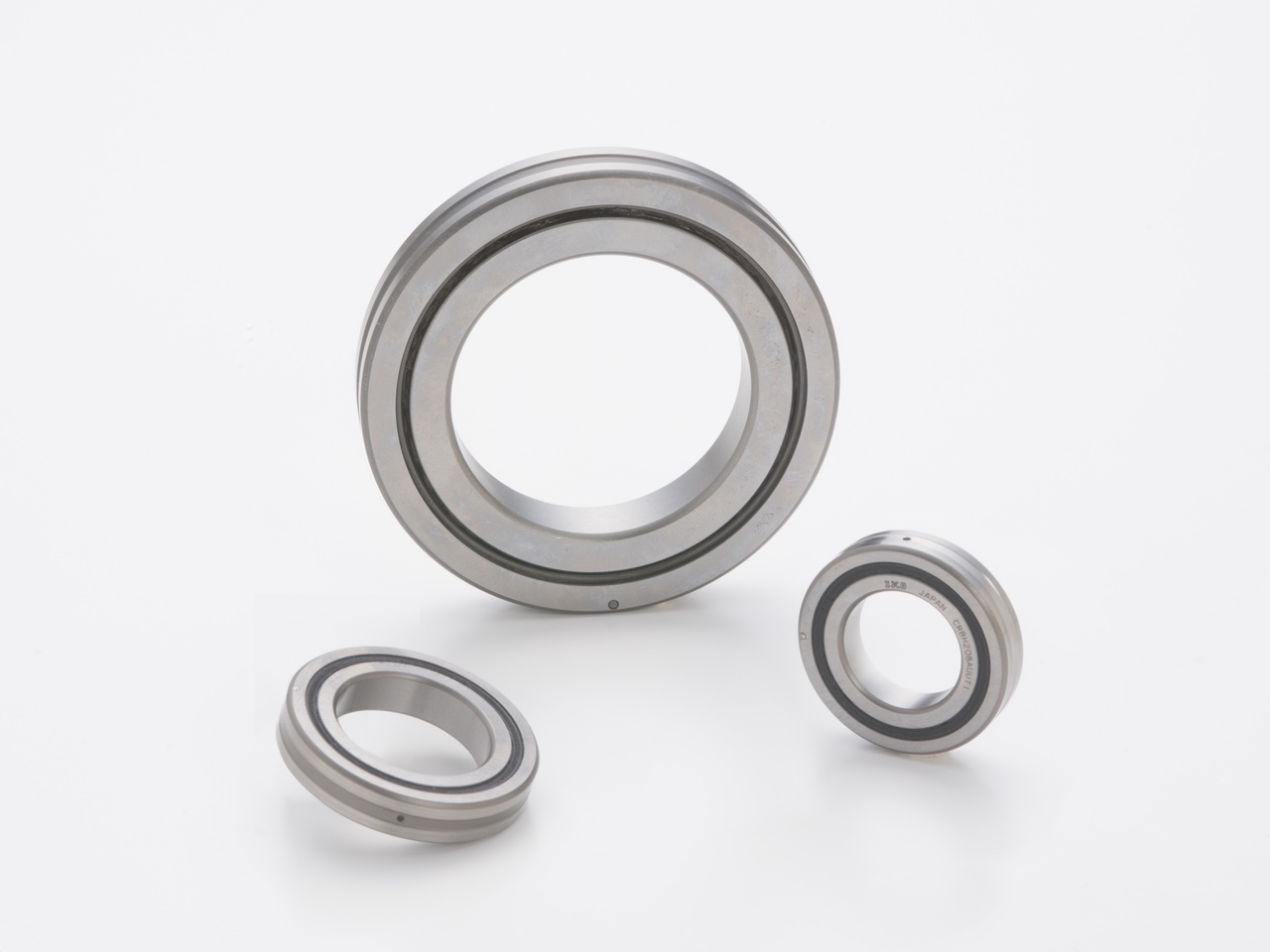How do different types of cross roller bearings, such as single and double split, differ in terms of design and functionality?
Various types of cross roller bearings, including single split and double split designs, exhibit differences in their design and functionality. These variations affect factors such as load capacity, rigidity, ease of installation, and axial displacement capability. Here’s a detailed explanation of the differences between single split and double split cross roller bearings:
- Single Split Cross Roller Bearings:
- Double Split Cross Roller Bearings:
Single split cross roller bearings consist of two separate parts – an inner ring and an outer ring. The inner ring is designed with a single split, allowing the bearing to be easily assembled and disassembled around the equipment shaft or housing. This design simplifies the installation process and reduces the need for complex adjustments. Single split cross roller bearings typically have a higher load capacity compared to double split designs, making them suitable for applications that require greater radial and axial load handling.
Double split cross roller bearings consist of three separate parts – an inner ring and two outer rings. Both the inner and outer rings have double splits, allowing the bearing to be easily separated into individual components. The double split design provides enhanced rigidity and axial displacement capability compared to single split bearings. Double split cross roller bearings can accommodate higher axial loads and have improved resistance to moment loads, making them suitable for applications that require increased rigidity and load-carrying capacity.
In terms of functionality, both single split and double split cross roller bearings offer advantages in different scenarios. Single split bearings are often preferred in applications where ease of installation, disassembly, and maintenance are critical factors. They are commonly used in machine tools, industrial robots, and other equipment that requires frequent assembly or adjustment. Single split bearings provide flexibility and convenience during installation and servicing processes.
On the other hand, double split cross roller bearings excel in applications that demand higher rigidity, increased load capacity, and improved resistance to moment loads. The double split design enhances the bearing’s ability to handle axial loads and maintain stability under challenging operating conditions. Double split bearings are commonly used in precision machinery, robotics, aerospace systems, and other applications where high rigidity and load-carrying capacity are essential.
In summary, the main differences between single split and double split cross roller bearings lie in their design and functionality. Single split bearings feature a simpler two-part design, allowing for easy assembly and disassembly. They offer higher load capacity but may have limitations in terms of rigidity and axial displacement capability. Double split bearings, with their three-part design, provide enhanced rigidity, improved axial load handling, and increased resistance to moment loads. The choice between single split and double split cross roller bearings depends on the specific requirements of the application, balancing factors such as load capacity, rigidity, ease of installation, and axial displacement capability.
How do cross roller bearings contribute to the proper functioning of aerospace components?
Cross roller bearings play a crucial role in ensuring the proper functioning of aerospace components. These bearings offer several benefits and contribute to the reliable and efficient operation of various aerospace systems. Here’s a detailed look at how cross roller bearings contribute to the proper functioning of aerospace components:
- Compact Design:
- High Load Capacity:
- Stiffness and Precision:
- Low Friction and Energy Efficiency:
- High-Speed Capability:
- Reliability and Durability:
Cross roller bearings have a compact design that allows for efficient use of space in aerospace components. Their thin and lightweight structure enables them to be integrated into tight spaces without adding excessive weight or bulk. This compact design is especially advantageous in aerospace applications where weight reduction and space optimization are critical factors.
Cross roller bearings are designed to handle high radial, axial, and moment loads. They feature crossed rollers arranged at right angles to one another, which enables them to distribute load forces in multiple directions. This high load capacity is essential in aerospace components that experience significant forces and loads during operation, such as landing gear systems, control surfaces, and actuators.
Cross roller bearings offer high stiffness and precision, making them suitable for aerospace applications that require precise positioning and motion control. Their unique design and preloaded arrangement of rollers result in minimal deflection and high rigidity, ensuring accurate and repeatable performance. Aerospace components, such as robotic arms, control mechanisms, and guidance systems, benefit from the stiffness and precision of cross roller bearings.
Cross roller bearings are designed to minimize friction and energy losses. The rolling contact between the crossed rollers and raceways reduces friction, resulting in smooth and efficient motion. This low friction characteristic contributes to energy efficiency in aerospace systems, where reducing power consumption and maximizing operational efficiency are crucial considerations.
Cross roller bearings are capable of operating at high speeds without sacrificing performance. Their low rotational inertia and optimized design allow them to handle rotational speeds encountered in aerospace applications, such as turbine engines, gearbox systems, and rotating assemblies. The ability to maintain performance and reliability at high speeds is essential for aerospace components that operate under demanding conditions.
Cross roller bearings are engineered to provide high reliability and durability in aerospace environments. They are designed to withstand harsh operating conditions, including high temperatures, vibration, shock, and contamination. Aerospace components, such as aircraft engines, landing gear, and control systems, rely on the robustness and longevity of cross roller bearings to ensure continuous and safe operation throughout their service life.
In summary, cross roller bearings play a vital role in the proper functioning of aerospace components. Their compact design, high load capacity, stiffness, precision, low friction, high-speed capability, and reliability contribute to the efficiency, performance, and safety of various aerospace systems. By providing reliable motion control, load support, and durability, cross roller bearings are essential components in aerospace applications, enabling the successful operation of aircraft, spacecraft, and other aerospace platforms.
Can you explain the design principles of cross roller bearings and their functions?
Cross roller bearings are designed based on specific principles to achieve their unique performance characteristics. The design principles of cross roller bearings encompass various aspects, including the arrangement of rollers, the structure of rings, and the preload mechanism. Understanding these design principles helps in comprehending the functions and advantages of cross roller bearings. Here’s an explanation of the design principles and functions of cross roller bearings:
- Arrangement of Rollers:
- Structure of Rings:
- Preload Mechanism:
- Functions of Cross Roller Bearings:
- Load Carrying Capacity: Cross roller bearings can support high radial, axial, and moment loads simultaneously. The cross arrangement of rollers allows for efficient load distribution, enabling the bearings to handle complex loads with high capacity.
- Compact and Space-Saving: The arrangement of rollers and the thin-walled ring structure contribute to the compactness of cross roller bearings. They occupy less space compared to other bearing types, making them suitable for applications with limited installation space.
- High Rigidity and Precision: The crossed roller design and the preload mechanism enhance the rigidity and precision of cross roller bearings. They minimize clearance, reduce deflection, and provide accurate positioning and motion control, making them ideal for applications that require high precision and stability.
- Moment Load Capability: Cross roller bearings can withstand both radial and axial moments. This capability enables them to support rotational movements and resist forces acting perpendicular to the bearing axis, making them suitable for applications with complex loads and moments.
- Low Friction and Wear: The rolling motion of cylindrical rollers reduces sliding friction, resulting in improved efficiency and reduced heat generation. Advanced lubrication techniques and high-quality materials further minimize friction and wear, contributing to extended bearing life and reduced maintenance requirements.
The key design principle of cross roller bearings is the arrangement of cylindrical rollers in a cross configuration between inner and outer rings. The rollers are oriented at right angles to each other and are alternately crossed, forming an X-shaped pattern. This arrangement allows for efficient load distribution, enabling cross roller bearings to support both radial and axial loads simultaneously. The crossed roller design enhances the load-carrying capacity while maintaining a compact profile.
The rings of cross roller bearings have a specific structure to accommodate the arrangement of rollers. The inner and outer rings are typically thin-walled, which helps reduce weight and improve the flexibility of the bearing. The thin-walled structure also contributes to the compactness of cross roller bearings, making them suitable for applications with limited space. The rings are precision-machined to ensure accuracy and rigidity, providing a stable foundation for the rollers.
Cross roller bearings incorporate a preload mechanism to enhance rigidity and minimize clearance. Preloading refers to applying a controlled axial force on the bearing components to eliminate any internal clearance. This axial force is achieved through various methods, such as using spacers, adjusting the ring thickness, or applying a preloading spring. The preload mechanism ensures that the rollers are in constant contact with the raceways, reducing backlash and improving the bearing’s precision and rigidity.
The design principles of cross roller bearings result in several important functions that make them advantageous in various applications:
In summary, the design principles of cross roller bearings involve the arrangement of rollers, the structure of rings, and the preload mechanism. These principles result in cross roller bearings with functions such as high load-carrying capacity, compactness, high rigidity and precision, moment load capability, and low friction and wear. Understanding these design principles and functions helps in appreciating the advantages and applications of cross roller bearings in various industrial sectors.
editor by CX 2024-02-17




